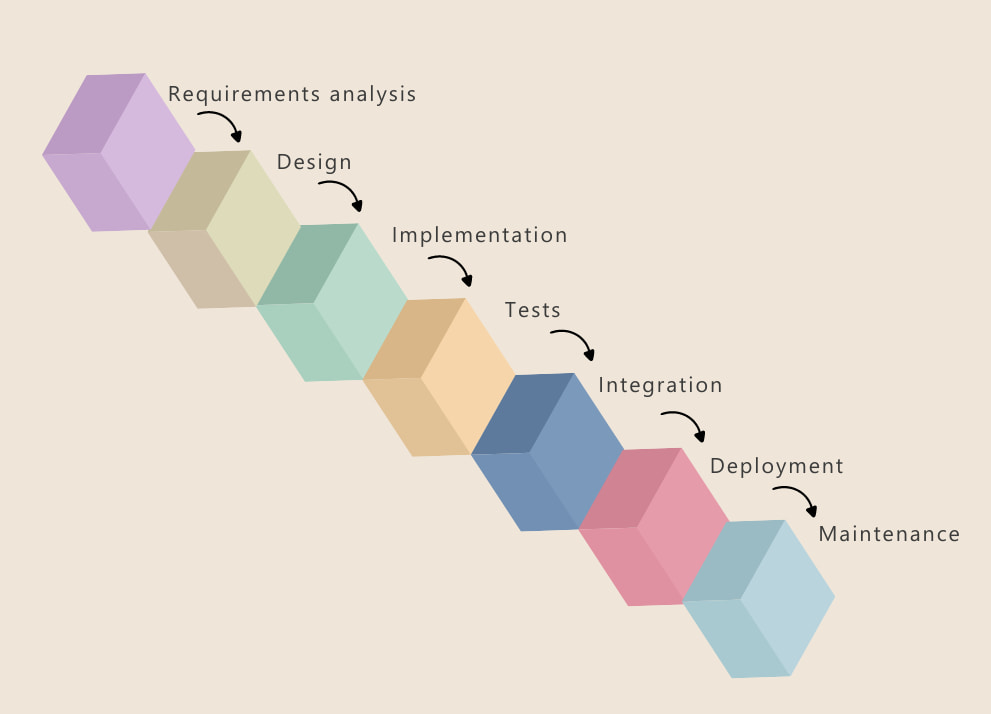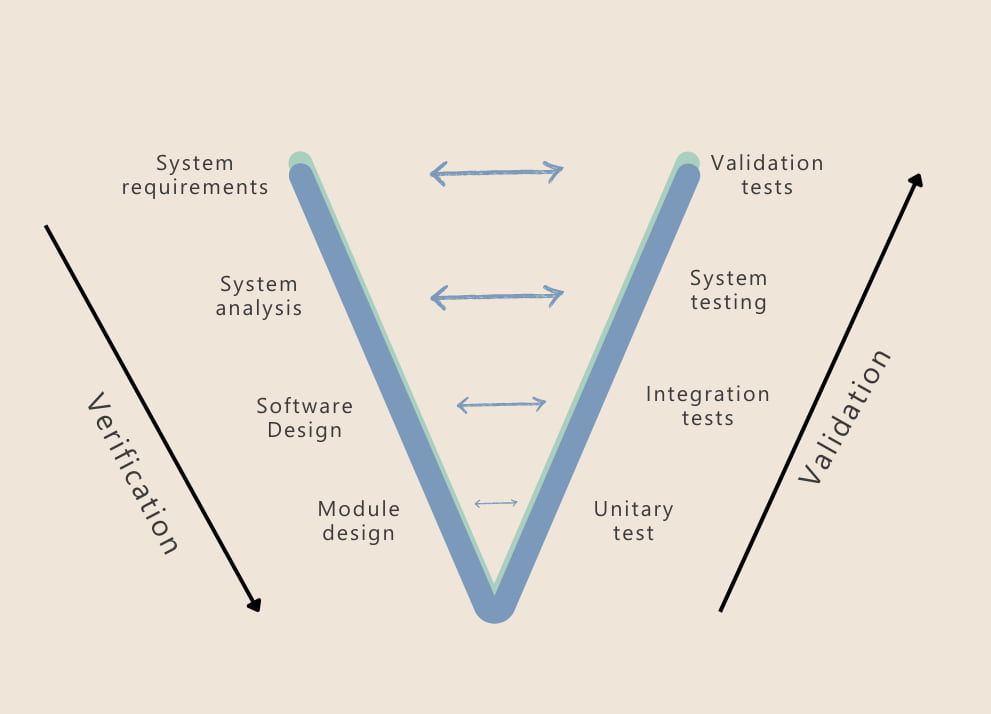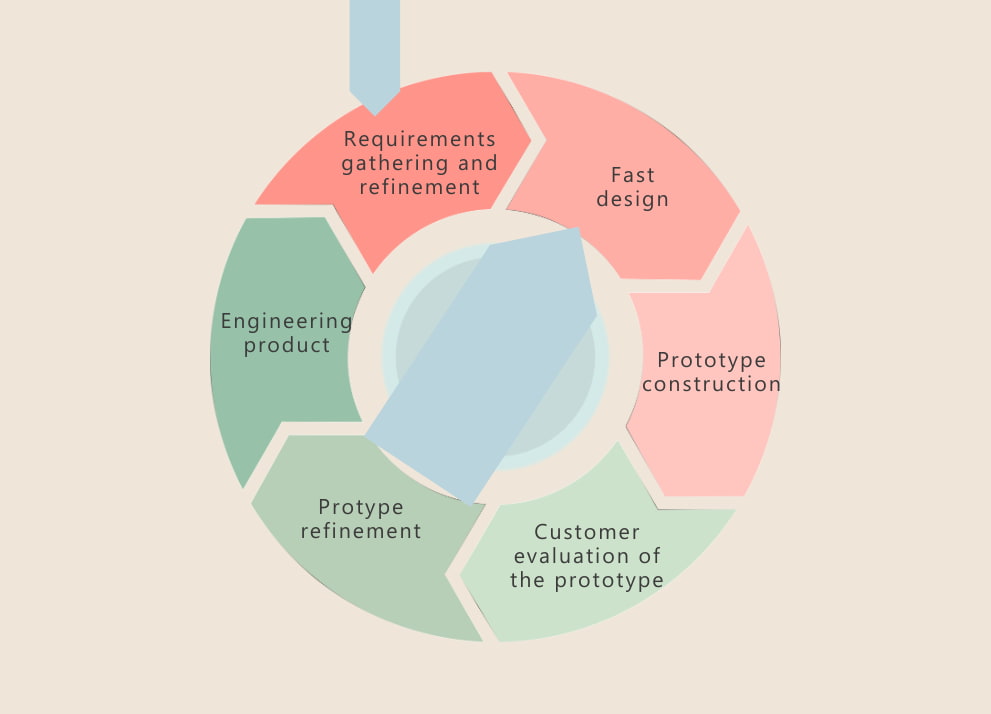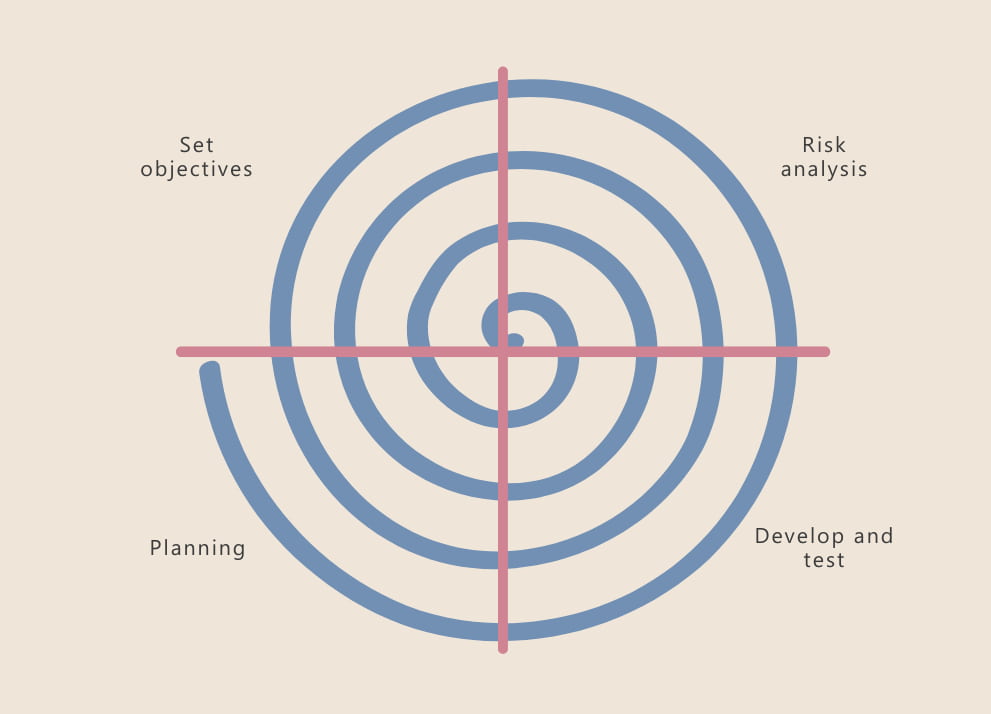Each software development life cycle model has its advantages and disadvantages, and its effectiveness depends on the nature of the project, the objectives, the available resources and the skills of the development team. The following are definitions and examples of the models mentioned:
Waterfall Model
Follows a linear and sequential approach, where each stage of the software development life cycle is completed before moving on to the next. Typical stages of the waterfall model include: requirements analysis, design, implementation, testing, integration, deployment and maintenance. It is useful for projects with clearly defined and stable requirements.

Advantages of the waterfall model:
1. it facilitates project planning and management, since stages and deliverables are clearly defined.
2. It facilitates the measurement of progress, since it is easy to determine at what stage the project is in.
3. Promotes communication and documentation, as each stage requires approval and documentation before moving to the next stage.
4. It can be efficient in terms of time and resources when requirements are clear and stable from the beginning.
Disadvantages of the waterfall model:
1. Little flexibility to adapt to changes in requirements, since any change requires reworking the previous stages.
2. User feedback and testing is performed at the end of the project, which may result in problems not detected until a late stage, increasing costs and correction time.
3. May not be suitable for long-term projects, where requirements and technologies may change over time.
4. The linear approach may result in wasted lead time and resources if one stage is delayed and subsequent stages depend on its completion.
In which projects is it ideal to use the waterfall model?
For example, this model would be ideal for a project to develop an inventory management system for a company with well-defined requirements and no expected changes in the short term for the following reasons:
1. The system requirements are clearly defined and are not expected to change, allowing for efficient planning and execution in a linear, sequential approach.
2. The structure and nature of the inventory management system are relatively simple and well understood, minimizing the likelihood of surprises or changes during the development process.
3. Thorough documentation and clear communication between stages, which are features of the waterfall model, can be beneficial in ensuring that all aspects of the system are properly designed and implemented.
4. The business may be more interested in obtaining a high-quality, well-documented end product rather than a quick delivery of partial functions, which makes the end-to-end approach of the waterfall model more appropriate.
V - Model
This model is an extension of the waterfall model, where testing activities are planned in parallel with development activities. Each development stage is associated with a corresponding test stage. For example, requirements analysis is associated with requirements validation, high-level design with integration testing, and low-level design with unit testing.

Advantages of the V-model:
1. Greater emphasis on software quality and verification, since testing is planned and executed in parallel with development.
2. Allows bugs to be detected and corrected early in the development process, which can reduce costs and correction time.
3. Easier communication between the development and test teams, as they work closely together throughout the process.
4. Improves the efficiency of the development process by combining the advantages of the waterfall model with a more systematic and rigorous approach to testing.
Disadvantages of the V-model:
1. Like the waterfall model, has little flexibility to adapt to changes in requirements once the development process has begun.
2. It can be more costly and time consuming than the waterfall model due to the additional focus on testing and verification.
3. Requires effective coordination and communication between the development and test teams to ensure that testing activities are performed as planned.
4. May not be suitable for long-term or evolving projects where requirements and technologies may change over time.
In which projects is it ideal to use the V-model?
For example, it is ideal for a QA software development project, where software verification and validation are as important as software development. This is so for the following reasons:
1. Software quality is critical in a quality control system, and the V-model places a strong emphasis on verification and validation through rigorous testing at each stage of development.
2. The development process benefits from close collaboration and communication between the development and testing teams, ensuring that the software meets the expected requirements and quality standards.
3. Early detection of bugs and correction throughout the development process can result in a more robust and reliable final product.
4. If the QA system requirements are well defined and are not expected to change significantly, the V-model provides a structured and efficient approach to development and testing.
Prototype Model
The prototyping model is a software development approach that focuses on creating functional prototypes of the system before developing the final version. This model allows developers and customers to gain a clearer understanding of system requirements, validate functionality and make adjustments before moving to the full development phase. It is an iterative approach that can adapt to changing requirements and customer expectations.

Advantages of the prototyping model:
1. It simplifies the communication between the developers and the client, since it provides a visual and functional representation of the system.
2. Allows early detection of bugs and problems, which helps reduce costs and risks associated with software development.
3. Facilitates the incorporation of changes in requirements and customer expectations, which increases customer satisfaction and the likelihood of project success.
4. Prototypes can be reused in the development phase, which can speed up the process and reduce overall development time.
Disadvantages of the prototyping model:
1. it can be more time and resource consuming compared to other development models, as it requires the creation and review of multiple prototypes.
2. There is a risk that developers will focus on prototyping instead of addressing the fundamental aspects of the system.
3. Customers may have unrealistic expectations regarding the time and resources required to develop the final product, as prototypes may give an impression of rapid progress.
4. There may be a lack of adequate documentation and planning, which may affect the quality and stability of the final product.
In which projects would it be ideal to use the prototyping model?
One project where it would be ideal to use this software development lifecycle model would be the development of an innovative mobile application for a company looking to expand into new markets. Since the success of the application is highly dependent on user satisfaction and adapting to their changing needs, the prototyping model would be optimal in this case.
The prototyping model would allow developers and the customer to get early feedback from users and make rapid adjustments to the application's functionality. In addition, the iterative approach would facilitate adaptation to changing requirements and customer expectations, which is essential in a constantly evolving market. In summary, the prototyping model would help ensure that the mobile application is developed efficiently and tailored to the specific needs of the users and the target market.
Spiral Model
The spiral model is a software development approach that combines elements of the classical lifecycle model, such as the waterfall model, with an iterative and evolutionary approach, such as the prototyping model. This model consists of four main phases: goal setting, analysis and risk assessment, development and testing, and planning. These phases are repeated in spiral cycles throughout the project, allowing for greater flexibility and adaptability to changes in the project requirements and environment.

Advantages of the spiral model:
1. Focus on risk management: Allows early identification and assessment of risks, which helps to minimize potential problems and make informed decisions during development.
2. Easily adapts to changes in customer and project requirements, resulting in higher customer satisfaction and a greater likelihood of project success.
3. Iterative development: Facilitates prototyping and customer feedback, which helps refine and improve the product before final release.
4. Greater control over the project: The incremental approach provides better visibility and control over project progress, allowing resources and time to be adjusted as needed.
Disadvantages of the spiral model:
1. Complexity: It can be more difficult to manage and understand compared to other development models, due to its focus on risk management and its iterative nature.
2. Cost: May be more costly than other development models, as it requires a greater investment in time and resources to assess risks and perform iteration.
3. Time: The risk analysis and assessment process can lengthen development time, especially if risks are not properly identified or managed.
4. Lack of structure: There may be a lack of proper documentation and planning, which can affect the quality and stability of the final product.
In which projects would it be ideal to use the spiral model?
An example of a project where it would be ideal to use the spiral model is the development of a state-of-the-art air traffic control system. This type of project is highly complex, involves advanced technologies and must meet stringent safety and performance requirements.
The spiral model would be optimal in this case, as it allows for a structured and systematic approach to risk identification and management, which is essential in a highly complex and responsible project. In addition, the iterative approach would allow developers and domain experts to work together to refine and improve the system over time, ensuring that customer expectations and needs are met. In summary, the spiral model would provide an efficient and flexible framework for approaching a project of high complexity and risk, such as the development of a state-of-the-art air traffic control system.
Incremental Development
This model is based on delivering functional parts of the software in increments, allowing users to test and provide feedback at each stage. The product is designed, implemented and tested incrementally, through small iterations, rather than performing the entire process at once. It is useful in projects where requirements may evolve over time and rapid delivery of features is expected.

Some advantages and disadvantages of the incremental development model are listed below.
Advantages:
1. Fast delivery of functionality: By developing and delivering parts of the software in increments, customers can start using the features earlier.
2. Flexibility: The incremental development model allows changes in requirements and design to be made easily, since iterations can be adapted to new needs.
3. Risk reduction: By dividing the project into increments, risks can be more easily identified and addressed at each stage.
4. Facilitates feedback: Customers can provide feedback at each increment, allowing adjustments and improvements to be made in the next increment.
5. Fewer defects: By focusing on small parts of the software in each increment, it is easier to test and fix bugs before they accumulate.
Disadvantages:
1. More complex planning and management: The incremental model requires detailed planning and management to ensure that each increment is completed on schedule.
2. Requires experience: It is necessary to have a team experienced in the incremental approach to ensure that the project is developed efficiently.
3. Potential for cohesionless increments: There may be difficulties in properly integrating increments if they are not properly planned.
4. Not suitable for projects with well-defined and stable requirements: This model is more suitable for projects where requirements may change or evolve during the development process.
In which projects would it be ideal to use the incremental model?
A mobile application development project for an e-commerce platform would be an ideal example for using the incremental development model. In this case, customer requirements are likely to change over time and need to adapt quickly to new market trends.
The incremental development model is ideal in this case because it allows for greater flexibility in changing requirements, which is critical in the ever-changing e-commerce environment. In addition, by delivering functionality in increments, early feedback can be obtained from users and improvements can be made in subsequent iterations, ensuring a high quality product that adapts to market needs.
In this case, other models such as the waterfall model would not be ideal, as they do not allow for changes to requirements once development has begun and do not provide incremental deliverables that facilitate early feedback from users.
Agile Methodologies
These methodologies focus on collaboration, adaptability and rapid delivery of value through short iterations called sprints. Agile methodologies, such as Scrum and Kanban, are useful in projects where flexibility and adaptability to frequent changes are required.
These methodologies focus on collaboration, adaptability and rapid delivery of high quality products. Some advantages and disadvantages of agile methodologies are listed below.
Advantages:
1. Adaptability: Agile methodologies allow easy adaptation to changes in requirements, which is essential in projects with uncertainty and constant evolution.
2. Collaboration: Communication and collaboration between team members and customers are essential in agile methodologies, leading to higher customer satisfaction and higher quality products.
3. Rapid delivery: Agile methodologies focus on rapid delivery of functional products, allowing customers to use and evaluate features as they are developed.
4. Continuous improvement: Feedback and constant improvements are fundamental in agile methodologies, allowing the optimization of the development process and the creation of higher quality products.
5. Risk reduction: Agile methodologies allow risks to be identified and addressed early and efficiently, reducing the impact of problems on the project.
Disadvantages:
1. Less predictable: The adaptable and flexible approach of agile methodologies can make it difficult to accurately estimate project timelines and costs.
2. Requires experience: Adopting agile methodologies can be difficult if the team does not have previous experience with these approaches.
3. Not suitable for all projects: Agile methodologies may not be ideal for projects with very stable and well-defined requirements, or for projects where documentation is critical.
4. Need for commitment and collaboration: Lack of commitment and collaboration among team members and customers can hinder project success in an agile environment.
In which projects would it be ideal to use agile methodologies?
A social networking platform development project would be an ideal example for using agile methodologies. In this case, client requirements are likely to change over time and need to adapt quickly to new trends and user needs.
Agile methodologies are ideal in this case because they allow for greater adaptability to changing requirements and market trends, which is critical in the social networking environment. In addition, by focusing on collaboration and communication, early feedback can be obtained from users and continuous improvements can be made to the product, ensuring a high quality product that adapts to the needs of users.
In this case, other models such as the waterfall model would not be ideal, as they do not allow for changes in requirements once development has begun and do not provide rapid deliveries that facilitate early user feedback and adaptability to the changing social networking environment.
In summary, choosing the right software development lifecycle model depends on the specifics of each project and the needs of the organization and it is essential to choose it correctly before starting a project to ensure efficient and successful product planning, execution and delivery. If you would like to know more about software development lifecycle models visit this article.